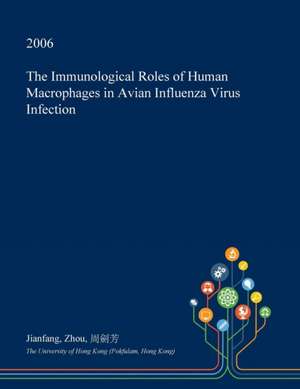The Immunological Roles of Human Macrophages in Avian Influenza Virus Infection
Autor Zhou, Jianfang Creat de 周劍芳en Limba Engleză Paperback
Abstract:
Abstract of thesis entitled
The Immunological Roles of Human Macrophages in Avian Influenza Virus Infection
Submitted by
Zhou Jianfang
for the degree of Doctor of Philosophy at the University of Hong Kong in May 2006
Severe human disease due to the highly pathogenic avian influenza virus H5N1 was first detected in Hong Kong in 1997. Recently, the epidemics of H5N1 infection in poultry and direct transmission to human with high mortality indicate an increasing threat to the
human population. Human H5N1 infection is characterized by marked mononuclear cell infiltration in the lung and hyperinflammatory cytokine response. Macrophages function as essential sensors in host and are responsible for numerous inflammatory, immunological and metabolic processes. The inflammatory and cytotoxic activities of human monocyte-derived macrophages (MDMs) in response to avian influenza viruses as well as T cell responses to the soluble factors released by virus-infected MDMs were demonstrated herein.
We investigated if the developmental status of MDMs affects cytokine and chemokine responses to influenza viruses. The infectivity, chemokine and interferon (IFN) responses between neonatal and adult MDMs infected with human influenza virus A/Hong Kong/54/98 (H1N1) (H1N1/98) and avian influenza virus A/Hong Kong/483/97 (H5N1) (H5N1/97) or its precursor A/Quail/Hong Kong/G1/97 (H9N2) (H9N2/G1) were compared. Significantly higher expressions of CCL2, CCL3, CCL5, CXCL10, and type I IFN were detected in avian influenza as compared with those in human influenza in spite of similar infectivity and viral replication. Compared to neonatal MDMs, stronger responses of CCL3, CCR1 and CCR5 were found in H5N1/97-infected adult MDMs. These data suggested that host factors may determine the disease process or outcome.
We next demonstrated the release of functional death receptor ligands (DRLs) and cytotoxicity of influenza virus infected-MDMs by using Jurkat T cells and human primary T blast cells as target cells. Significant upregulation of tumor necrosis factor (TNF)-α and TNF-related apoptosis inducing ligand (TRAIL), but not FasL mRNA was detected in human MDMs infected with H5N1/97 or H9N2/G1. H5N1/97-infected MDMs exhibited the strongest induction of apoptosis in Jurkat T cells. Furthermore, direct influenza virus infection enhanced the sensitivity of Jurkat T cells to apoptosis induced by TNF-α, TRAIL and FasL. Moreover, the supernatants from virus-infected MDMs induced apoptosis in primary T blasts. This apoptosis was inhibited by the combination of TNF-α, TRAIL and FasL inhibitors. Our data suggested that functional TRAIL and TNF-α produced by influenza virus-infected MDMs and the enhanced sensitization to DRLs-induced apoptosis detected in avian influenza may contribute to the lymphopenia observed in human H5N1 infection. To define the regulatory effects of chemokines and cytokines in avian influenza on lymphocytes, anti-CD3-activated human T lymphocytes were stimulated with the supernatants from avian virus H9N2/G1-infected MDMs. T cell activation including CD25 expression, interleukin (IL)-2 production and cytotoxic activity were impaired as compared with those treated by supernatants from human virus H1N1/98-infected MDMs. No significant inhibition of T cell proliferation and IFN-γ production was observed. The impairment exhibited by
Preț: 374.63 lei
Preț vechi: 394.35 lei
-5% Nou
71.69€ • 75.03$ • 59.66£
Carte indisponibilă temporar
Specificații
ISBN-10: 1374665509
Pagini: 278
Dimensiuni: 216 x 280 x 15 mm
Greutate: 0.65 kg
